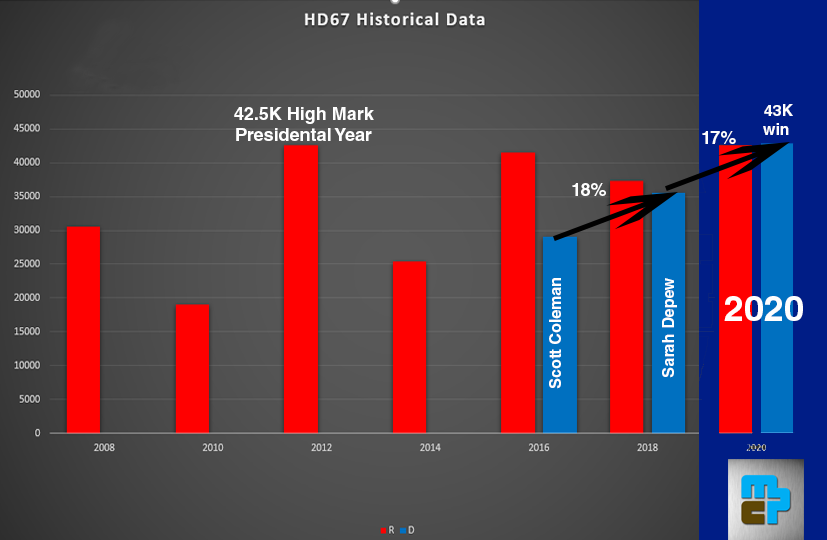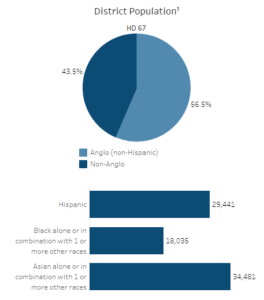Texas House 67 is getting a lot of attention this year as we head into the November elections. That is because in 2018 the Democrat came within sixteen hundred votes of winning against Jeff Leach the incumbent Republican. As a result of that tight race, HD67 has been targeted by national and state groups to flip blue.
 The real question is will it? To take an educated guess I have pulled the election results for the past 10 years to get a real feel for how this district has performed. Like so many suburban districts in Texas, the GOP has had very little competition until the past couple of elections as Democrats have ceded the district. Looking at my chart, you will notice that it was not until 2016 that a Democrat challenger jumped in. Scott Coleman stepped into those unchartered waters and ran, setting the initial watermark of 41% as he began the process of activating Democrats to the possibility of having representation at the state level.
The real question is will it? To take an educated guess I have pulled the election results for the past 10 years to get a real feel for how this district has performed. Like so many suburban districts in Texas, the GOP has had very little competition until the past couple of elections as Democrats have ceded the district. Looking at my chart, you will notice that it was not until 2016 that a Democrat challenger jumped in. Scott Coleman stepped into those unchartered waters and ran, setting the initial watermark of 41% as he began the process of activating Democrats to the possibility of having representation at the state level.
In 2018, Sarah Depew picked up the mantle and ran against Jeff Leach. Through her efforts and the Beto/ Trump effect impacting the elections and causing a surge in voters, she came within 1.6K votes. A very remarkable 18% increase of Democratic voters in just 2 years. The question is can Democrats bring this seat over to our blue table? To do that we will have a few obstacles to overcome.
This is a presidential year and to figure out roughly what the winning number is we must look at other presidential years to see what our win number needs to be. 2018 was a midterm election, and while the numbers were high, historically midterm number are well below presidential election years. In 2012, which was the year of Obama’s reelection and had a lot of GOP voters up in arms, 42.6K GOP voters went to the polls and voted for Jeff Leach. That is the best mark of what the GOP is capable of delivering to the polls in the past decade. In many of Texas House Districts I have analyzed, the GOP number has been flat for the past decade, HD67 is no exception.
With this in mind, the eventual Democrat would need 43K votes to win, assuming there is not a hidden cache of non-voting GOP voters that run to the polls. This would represent a 17% increase from 2018 results, which is an additional 7400 voters. While I do not have a magic eight ball, I do believe that this number is quite achievable given the current political storm we find ourselves in. If anything GOP turn-out may be down as infrequent federal voters, who only vote in presidential years, are demoralized by Trump and don’t bother to go to the polls. Democrats, on the other hand, may be determined to end the presidency of trump after four hard years and restore a president more to our liking.

